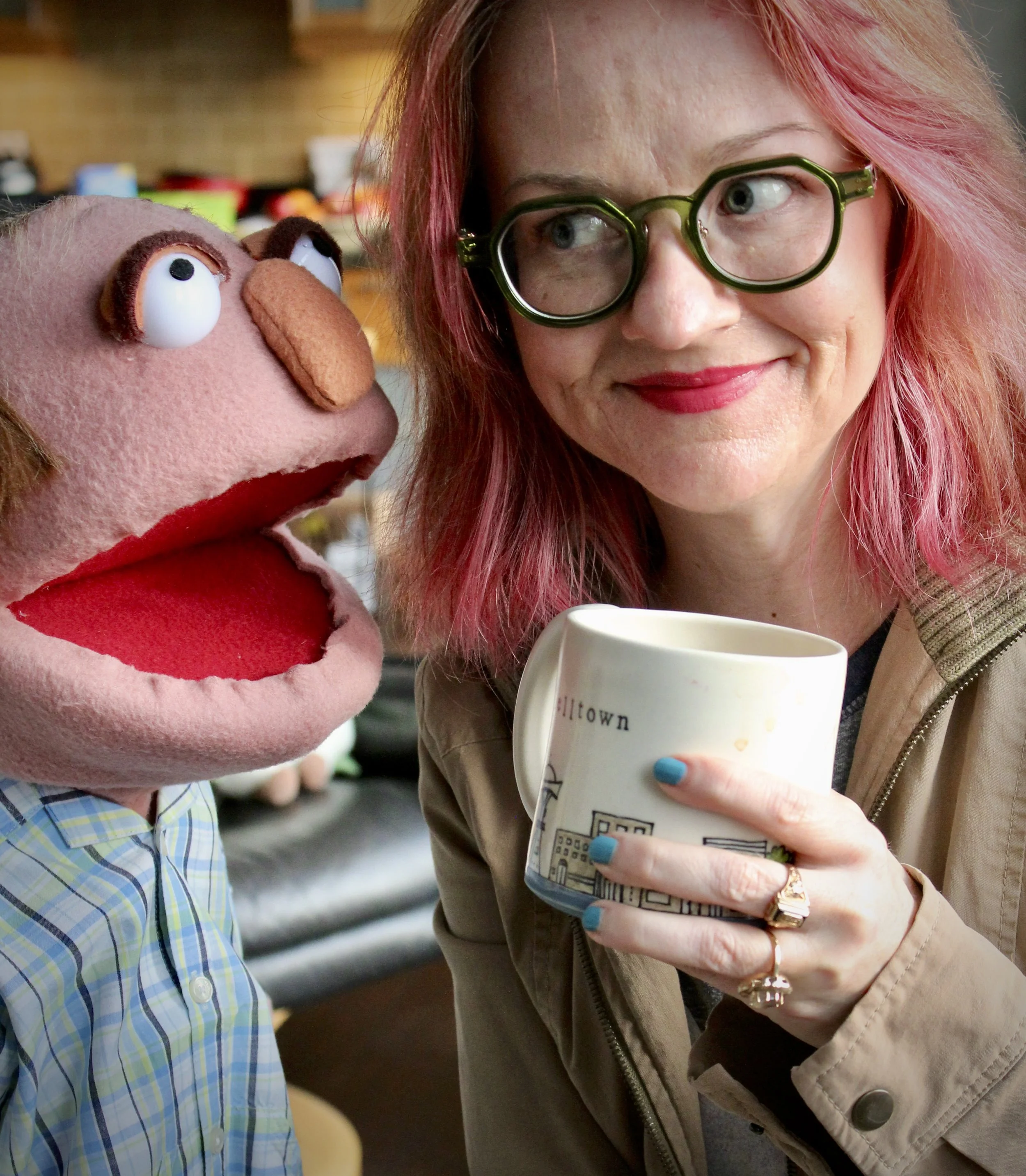The Puppet Who Lived Downstairs
Reading time: About 8 minutes.
My neighbors were so unbelievable, I had to turn them into puppets. Turns out, they’re more human than I expected—and so am I.
My puppet Gary and me in awkward conversation back in 2022.
Most people bake cookies. Or knit hats. Or dabble in watercolor.
I build puppets.
Not the sweet, googly-eyed kind that sing the ABCs. Mine are furry sculptures based on real people—neighbors, mostly. The kind of people who corner you in the mailroom to tell you their house in Chicago was on the same block as the house in the Home Alone movie. The kind who say, mid-party, that they keep a list of “second wives” in case their current one kicks the bucket.
It started as a coping mechanism. Or maybe performance art. Or maybe revenge. I’m still not sure. But somewhere along the way—between sculpting eyebrows and hot-gluing tiny bendable fingers—I stopped rolling my eyes and started wondering about these people. And now, every puppet I make begins as an eye-roll and ends as a sort of love letter.
Gary (A Study in Cringes)
The first puppet I ever made was based on a man named Gary, who lived a few floors below me and seemed constructed entirely of grievances and cholesterol.
Gary was the kind of person who announced himself long before entering a room. People scattered when he drew near. He referred to himself as the “building historian,” which mostly meant he spoke at HOA meetings with the authority of someone who had printed his own title on a nameplate. He complained about elevator efficiency, hallway lighting—and during several different meetings, he insisted, I kid you not, that he should have access to the security camera feeds so he could see who was coming and going.
He had a voice like gravel wrapped in legalese and a face that always looked slightly annoyed to still be alive. He’d corner you in the mailroom with long-winded stories about his former life as an attorney in Chicago. He never just said he was an attorney. He said things like, “I was counsel on some very significant cases,” before casually mentioning how much he paid for his BMW and how his house in Chicago was on the same street as the Home Alone house.
But it was one conversation at a party that pushed me from mild repulsion into puppet-crafting mode. He leaned in and said, “I’ve got a list of second wives lined up in case something happens to my first.” He winked—winked—and added, “Don’t worry, you’re not on it. You’re married.”
Which was, frankly, the kind of unsettling relief that makes you want to check for hidden cameras. I wasn’t flattered. I wasn’t offended. I was… relieved? Which made no sense, because marriage to him would’ve been unthinkable—ring or no ring.
I went home that night and couldn’t stop hearing his voice. The cadence, the bravado, the cringey insinuations. And then I saw him—in my mind—as a puppet. A little felt Gary with a combover and furry eyebrows. And I thought, Okay. Let’s do this.
At first, it was satire. A harmless exorcism. A way to turn my frustration into something funny. But the thing is, when you’re building someone—even in puppet form—you start to notice details. You start to wonder why they are the way they are.
Gary had talked about his strokes. About his “double diabetes.” About how his wife “wasn’t getting any younger,” and how he might outlive her—which is why he needed a backup plan. It was awful. And also, sort of sad. Not because he might be alone, but because he clearly didn’t know how to be alone.
And then I started noticing something. His rants at meetings? Unlike other neighbors, his rants weren’t just for himself. He cared—truly cared—about the building. About community. He just didn’t know how to say it in a way that didn’t also insult everyone. The request for access to the security feeds? He wanted to make sure people weren’t holding the doors open for strangers—something our building actually has a rule about after several packages went missing. Gary’s delivery was gruff and overbearing. But his intentions? Surprisingly civic-minded.
When he died, I felt… a pang. Not just of liberation (though I’ll admit, the mailroom became 30% more breathable). But of loss. Because the world had one less colorful character. One less jagged-edged, impossible-to-ignore, utterly human person. It made my world a little less interesting. A little less alive.
And I still have his puppet. I still hear his voice.
From Caricature to Curiosity (and Back Again)
Building Gary opened the floodgates. Once you’ve seen one person as a puppet, you start seeing everyone that way. The flight attendant who lingers in the lobby to recount her dating dramas and broken toe saga. The tall guy with a Porsche who wants the HOA to negotiate dimmer parking lot lights across the street—as if we have jurisdiction over public infrastructure. The neighbor who invented the thong. (We’ll get to him in a minute.)
Each puppet begins with a kind of exasperated marvel—I cannot believe they just said that—and ends, somehow, with tenderness. Because when you’re shaping hairlines onto someone’s felt doppelgänger, it’s hard to stay mad. You start wondering: What must it be like to walk through the world as them? What are they trying to say with all this bluster? Who are they hoping will hear them?
Take Fernando, for instance. Older gentleman. Salt-and-pepper curls. Argentinian accent. Gold chains. Tracksuits. He claims—often and without prompting—that he invented the thong during his days in high-end lingerie. He’s also the kind of guy who, if he does you a favor, believes you now owe him a lifetime of small-to-medium tasks.
And yet: Fernando is also thoughtful. He wants to be liked. He’s generous in his own, deeply Fernando way. My next-door neighbor Mark often helped him with a few handyman things, and in return, Fernando offered him a place to stay in Paris. He also opened a trunk in his living room—what can only be described as a mobile Victoria’s Secret—and insisted Mark pick out anything he wanted to give his wife. Mark blushingly walked away with a stack of lacy underthings and, as a bonus, a satin blindfold that Fernando slipped onto the top of the stack. Because apparently, boundaries are not something Fernando invented.
Then there’s David—one of our front desk attendants and arguably the unofficial mayor of the building. Within minutes of meeting you, he’ll tell you three things: that he’s gay, that his siblings are conservative and exhausting, and that he watched all the episodes of Sex and the City (the original) over the weekend. He wears pop culture pins on his jacket, shaves his balding head into submission except for a dramatic rat’s tail down the back, and stretches his tight vintage t-shirts just a bit too far across his middle-aged belly. Every year on his birthday, he wears a crown. All shift. All day.
Dave is delightful. He is a lot. He is very good at his job. And if he’s working the front desk, you should budget an extra ten minutes to get through the lobby, because you will hear about his friends, his favorite movies, and his thoughts on local politics—possibly all in one breath.
I made puppets of Fernando and David as a going-away gift for Mark and Caroline. They’re the kind of neighbors who don’t need puppets to empathize with people because they are the best of humanity, but they appreciated the love (and the laugh) stitched into every bit of floof and felt. These two had become the building’s connective tissue, and their moving away felt like losing a vital thread. Giving them those fuzzy sculptures was my way of saying, “Here. Take a piece of this place with you. The weird, wonderful, exhausting heart of it.”
Because that’s what these puppets are. Tiny, woolly portraits of people we might otherwise roll our eyes at. And maybe we still do. But now we do it with affection.
The Puppetmaker in the Mirror
The thing about living in a building full of characters is, eventually, you have to admit: you’re one of them.
I may not brag about inventing the thong or wear a birthday crown to greet the mail carrier, but let’s be honest—I make puppets of my neighbors. I talk about them, talk to them, sometimes even talk as them. And not just in the privacy of my apartment. These puppets have made appearances in videos, in Zoom meetings, in birthday greetings for friends.
I live in a midrise soap opera with a rotating cast of eccentrics, and somehow, I’ve become the neighborhood’s unofficial archivist. Not with a nameplate or HOA minutes—but with fleece, thread, and a hot glue gun.
And the truth is, I love it.
I love that these fleecy sculptures have taught me how to pause before judging. That every eye-roll has the potential to become a tiny tribute. That when someone grates on my nerves, they might actually be a future puppet in progress—and that maybe, just maybe, they’re doing the best they can with whatever fraying seams life has handed them.
So yes. I live in a building full of characters. And I’m one of them. Just another neighbor with quirks, stories, and a secret drawer full of googly eyes and tiny tracksuits.
What about you?
Who’s the character in your neighborhood, office, or life that makes you want to build a puppet (or voodoo doll)?
What would your puppet look like? (And what would they say if they could talk back?)
Postscript: Names and details have been “fuzzed out” to protect the real-life characters behind these puppets. But don’t worry—the personalities are still stitched in.








